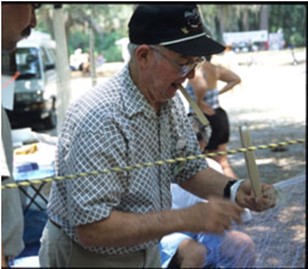Stuart Pacetti
2004 Florida Folk Heritage Award

Stuart Pacetti (St. Augustine) preserves the art of making English and Spanish castnets that achieve excellence in both form and function. Pacetti was born into a Minorcan family in St. Augustine. Pacetti first learned to use castnets at 12, when his father taught him to throw them. Together they would cast for mullet on the beach—a practice followed by the Minorcan colonists over 200 years ago, or for shrimp in the shallows of the St. Johns River. In 1955, Pacetti’s uncle, Thomas Delaney, taught him to make castnets. He in turn had learned from his uncle, Carl Canova, who had been a fine net maker and fisherman even though he was blind. Although Pacetti continued to make nets for the next fifteen years, he became very busy with his work and family. After high school, he took classes at North Florida College and became a plumber. In addition, he taught plumbing at St. Augustine Technical Center for 16 years. He married his beautiful wife, Irma, the same year he learned to make nets, and they had two sons. Although Pacetti retired in 1996, he remains very active, and can frequently be found making nets, fishing, or caring for his grapevines.
The basic castnet design has remained relatively unchanged since the Spanish first introduced it to Florida. The castnet consists of a circular piece of net rimmed with a rope called a leadline, which is threaded through small lead weights. The line is connected at the center to the handline, for retrieving the net. When thrown skillfully, the net spreads beautifully in a full circle upon the water—trapping fish as it settles to the bottom. As the fisherman pulls it in, it forms a bag that holds the fish. Spanish castnets differ from those introduced during the brief British colonial period in the way they are rigged to work when retrieved. Today most castnets are made from manufactured net, but they are bulky and do not cast as well as handmade ones.
Pacetti makes most of the tools needed for the netmaking process: wooden needles (or shuttles) from hardwoods such as dogwood, hickory or mulberry; flat cow bone gauges to ensure consistency in the weave; and lead sinkers. Making a net itself is a long, tedious process. Pacetti estimates that it takes about 160 hours and 74,000 knots to make an 8-foot shrimp net with 1/2 inch mesh monofilament nylon twine. However, materials and techniques have changed over time. The first nets Pacetti made were cotton, but they lasted only two years. Local netmakers found that nylon made a more durable product. Pacetti himself introduced the use of PVC pipe to create the “ring” or “horn” through which the handline passes.
One of Pacetti ‘s most heartfelt concerns is the loss of Florida’s traditional ways of life and the natural environment through growth and development. He passed on his netmaking knowledge to another Minorcan community member through the 2000-2001 Florida Folklife Apprenticeship Program. Perhaps the best testimony to his art is a description by St. Augustine resident Yulee Mickler: “I have been throwing cast nets since I was a teenager, about 55 years. I know cast nets, and his are a quality product. They are made to the same high standards of those made by my father, brothers and other old timers in the 1940s and 1950s. . . . Stuart’s nets are made so the knots don’t slip, the tucks don’t tangle, and because he uses monofilament, the weight is even better than those of the old timers’ nets. They are easy to throw and catch and hold fish and shrimp superbly. .. .Because he does such a good job, we are happy fishermen.”

